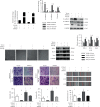LncRNA SNHG5 Suppresses Cell Migration and Invasion of Human Lung Adenocarcinoma via Regulation of Epithelial-Mesenchymal Transition
- PMID: 36711024
- PMCID: PMC9879674
- DOI: 10.1155/2023/3335959
LncRNA SNHG5 Suppresses Cell Migration and Invasion of Human Lung Adenocarcinoma via Regulation of Epithelial-Mesenchymal Transition
Abstract
Long noncoding RNAs (lncRNAs) are gradually being annotated as important regulators of multiple cellular processes. The goal of our study was to investigate the effects of the lncRNA small nucleolar RNA host gene 5 (SNHG5) in lung adenocarcinoma (LAD) and its underlying mechanisms. The findings revealed a substantial drop in SNHG5 expression in LAD tissues, which correlated with clinical-pathological parameters. Transcriptome sequencing analysis demonstrated that the inhibitory effect of SNHG5 was associated with cell adhesion molecules. Moreover, the expression of SNHG5 was shown to be correlated with epithelial-mesenchymal transition (EMT) markers in western blots and immunofluorescence. SNHG5 also had significant effects of antimigration and anti-invasion on LAD cells in vitro. Furthermore, the migration and invasion of A549 cells were suppressed by overexpressed SNHG5 in the EMT progress induced by transforming growth factor β1 (TGF-β1), and this might be due to the inhibition of the expression of EMT-associated transcription factors involving Snail, SLUG, and ZEB1. In LAD tissues, the expression of SNHG5 exhibited a positive association with E-cadherin protein expression but a negative correlation with N-cadherin and vimentin, according to the results of quantitative real-time PCR (qRT-PCR). In summary, the current work demonstrated that the lncRNA SNHG5 might limit cell migration and invasion of LAD cancer via decreasing the EMT process, indicating that SNHG5 might be used as a target for LAD therapeutic methods.
Copyright © 2023 Zhirong Li et al.
Conflict of interest statement
The authors declare that they have no conflicts of interest.
Figures






Similar articles
-
The long non-coding RNA SNHG5 regulates gefitinib resistance in lung adenocarcinoma cells by targetting miR-377/CASP1 axis.Biosci Rep. 2018 Aug 29;38(4):BSR20180400. doi: 10.1042/BSR20180400. Print 2018 Aug 31. Biosci Rep. 2018. PMID: 29592872 Free PMC article.
-
The lncRNA small nucleolar RNA host gene 5 regulates trophoblast cell proliferation, invasion, and migration via modulating miR-26a-5p/N-cadherin axis.J Cell Biochem. 2019 Mar;120(3):3173-3184. doi: 10.1002/jcb.27583. Epub 2018 Sep 22. J Cell Biochem. 2019. PMID: 30242892
-
LncRNA SNHG5 promotes cervical cancer progression by regulating the miR-132/SOX4 pathway.Autoimmunity. 2021 Mar;54(2):88-96. doi: 10.1080/08916934.2020.1864731. Epub 2021 Feb 23. Autoimmunity. 2021. PMID: 33622094
-
Resveratrol inhibits TGF-β1-induced epithelial-to-mesenchymal transition and suppresses lung cancer invasion and metastasis.Toxicology. 2013 Jan 7;303:139-46. doi: 10.1016/j.tox.2012.09.017. Epub 2012 Nov 9. Toxicology. 2013. PMID: 23146760
-
Latest Advances of Long Non-Coding RNA SNHG5 in Human Cancers.Onco Targets Ther. 2020 Jul 1;13:6393-6403. doi: 10.2147/OTT.S252750. eCollection 2020. Onco Targets Ther. 2020. PMID: 32753882 Free PMC article. Review.
Cited by
-
Developing a prognostic model using machine learning for disulfidptosis related lncRNA in lung adenocarcinoma.Sci Rep. 2024 Jun 7;14(1):13113. doi: 10.1038/s41598-024-63949-1. Sci Rep. 2024. PMID: 38849442 Free PMC article.
-
Construction of an EMT-related lncRNA prognostic signature for lung adenocarcinoma and functional verification of its hub gene LINC01615.J Cancer Res Clin Oncol. 2023 Dec;149(20):17781-17793. doi: 10.1007/s00432-023-05476-6. Epub 2023 Nov 7. J Cancer Res Clin Oncol. 2023. PMID: 37934255 Free PMC article.
-
Tumor necrosis factor-related lncRNAs predict prognosis and immunotherapy response for patients with lung adenocarcinoma.J Thorac Dis. 2023 Mar 31;15(3):1373-1386. doi: 10.21037/jtd-23-184. Epub 2023 Mar 27. J Thorac Dis. 2023. PMID: 37065578 Free PMC article.
References
-
- Han B., Jin B., Chu T., et al. Combination of chemotherapy and gefitinib as first-line treatment for patients with advanced lung adenocarcinoma and sensitive EGFR mutations: a randomized controlled trial. International Journal of Cancer . 2017;141(6):1249–1256. doi: 10.1002/ijc.30806. - DOI - PubMed
LinkOut - more resources
Full Text Sources
Research Materials

